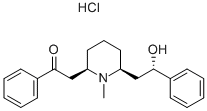| Identification | More | [Name]
alpha-Lobeline hydrochloride | [CAS]
134-63-4 | [Synonyms]
2-[(2r,6s)-6-[(2s)-2-hydroxy-2-phenyl-ethyl]-1-methyl-2-piperidyl]-1-phenyl-ethanone hydrochloride
[2-[(2R,6S)-6-[(2S)-2-HYDROXYPHENETHYL]]-1-METHYL-2-PIPERIDYL]ACETOPHENONE HYDROCHLORIDE
2-[6-(2-HYDROXY-2-PHENETHYL)-1-METHYL-2-PIPERIDYL]ACETOPHENONE HCL
2-(6-[2-HYDROXY-2-PHENYLETHYL]-1-METHYL-2-PIPERIDINYL)-1-PHENYLETHANONE HYDROCHLORIDE
A-LOBELINE HCL
A-LOBELINE, HYDROCHLORIDE
ALPHA-LOBELINE HYDROCHLORIDE
ALPHA-LOBELIN HCL
L-LOBELINE HYDROCHLORIDE
(-)-LOBELINE HCL
LOBELINE HCL, A-
(-)-LOBELINE HYDROCHLORIDE
LOBELINE HYDROCHLORIDE
(-)-id
2-(6-(beta-hydroxyphenethyl)-1-methyl-2-piperidyl)-acetophenonhydrochlor
2-[6-(.beta.-hydroxyphenethyl)-1-methyl-2-piperidyl]-,hydrochloride,(-)-Acetophenone
Lobelinhydrochloride
2-(6-(2-hydroxy-2-phenethyl)-1-methyl-2-piperidyl)acetophenone hydrochloride
Apolipoprotein B (LDL), Sheep anti-Human, Guinea pig, Swine (NO X w/Bovine, Horse, Dog, Cat, Rabbit, Chicken, Goat, Mouse, Rat)
2-(6-[2-Hydroxy-2-phenylethyl]-1-methyl-2-piperidinyl)-1-phenylethanone, L-Lobeline, Hydrochloride | [EINECS(EC#)]
205-150-2 | [Molecular Formula]
C22H28ClNO2 | [MDL Number]
MFCD00082455 | [Molecular Weight]
373.92 | [MOL File]
134-63-4.mol |
| Chemical Properties | Back Directory | [Appearance]
White to Off-White Solid | [Melting point ]
183-185 °C (dec.)(lit.)
| [alpha ]
D20 -43° (c = 2) | [refractive index ]
-57.5 ° (C=1, H2O) | [storage temp. ]
Inert atmosphere,Room Temperature | [solubility ]
H2O: 25 mg/mL
| [form ]
powder
| [color ]
white to off-white
| [optical activity]
[α]20/D 56.8°, c = 2 in H2O | [Usage]
A neuronal nicotinic acetylcholine receptor agonist. A respiratory stimulant | [Merck ]
5551 | [BRN ]
3920196 | [LogP]
3.610 (est) | [CAS DataBase Reference]
134-63-4(CAS DataBase Reference) |
| Safety Data | Back Directory | [Hazard Codes ]
T | [Risk Statements ]
R23/25:Toxic by inhalation and if swallowed . | [Safety Statements ]
S36/37/39:Wear suitable protective clothing, gloves and eye/face protection .
S45:In case of accident or if you feel unwell, seek medical advice immediately (show label where possible) . | [RIDADR ]
UN 1544 6.1/PG 3
| [WGK Germany ]
3
| [RTECS ]
OJ8490100
| [F ]
8 | [HazardClass ]
6.1(b) | [PackingGroup ]
III |
| Hazard Information | Back Directory | [Description]
(–)-Lobeline is an alkaloid that has been found in Lobelia and has diverse biological activities.1,2,3 It binds to nicotinic acetylcholine receptors (nAChRs) in rat brain homogenates (Ki = 4 nM) and has antinociceptive effects in the tail-flick assay in mice.1 (–)-Lobeline (0.3 and 0.9 mg/kg) reduces the number of errors in a repeated acquisition procedure in the radial arm maze in rats.2 It also decreases immobility time in the forced swim test and feeding latency in the novelty suppressed feeding test, indicating antidepressant-like activity, in mice when administered at doses of 1 and 4 mg/kg.3 | [Chemical Properties]
White to Off-White Solid | [Uses]
A neuronal nicotinic acetylcholine receptor agonist. A respiratory stimulant | [Uses]
A neuronal nicotinic acetylcholine receptor agonist. A CNS stimulant. | [Biological Activity]
High affinity nicotinic receptor ligand, with a K i value of 4.4 nM in rat brain. | [in vitro]
clastogenicity of lobeline and possible interactions between lobeline and ethyl alcohol were investigated in a mutagen-sensitivity assay on cultures of human lymphoblastoid cell lines. lobeline alone was not clastogenic, but there was a marked increase in genetic damage resulting from a coclastogenic interaction between lobeline and ethyl alcohol. [5] | [in vivo]
male c57bl/6j mice were individually housed and acclimatized to 10% alcohol. lobeline is a partial nicotinic agonist that attenuates alcohol consumption and preference in male c57bl/6j mice. [3] cf-1 male mice received an intraperitoneal injection of lobeline (5 or 10mg/kg). lobeline did not show genotoxic or mutagenic effects and did not increase the ethanol-induced genotoxic effects in blood. lobeline also protected blood cells against oxidative damage induced by hydrogen peroxide. [4] |
|
|





